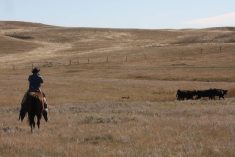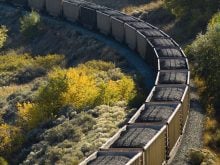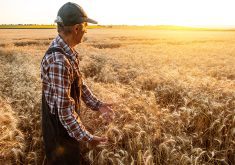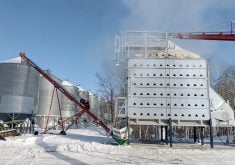Glacier FarmMedia – A major insurer and lender is expanding eligibility and incentives for a loan dedicated to young and new ag producers in Alberta.
The Agricultural Financial Services Corporation’s (AFSC) Next Generation Loan program is meant to provide these producers with “a consistent source of fixed-rate term loans to establish their own farming operation,” according to the AFSC website.
The following changes to the program will take effect Sept. 1:
Read Also

Alberta researcher helps unlock the economics of farming
Lethbridge Polytechnic researcher helping agriculture producers with decision-making tools in economic feasibility
Producers of any age who are entering or returning to farming are eligible for a one per cent interest rate incentive, while before it was only available to those under age 40.
Producers may receive an interest rate incentive on their total lifetime loan principal up to $1.5 million, an increase from the previous $1 million.
Applicants now require 20 per cent ownership in a farming operation, down from 25 per cent.
Eligible borrowers can make “interest-only” payments on their loans for up to five years, up from the current two years.
“Over the past 20 years, the number of young and middle-aged producers in agriculture has seen steep declines, while the number of farmers over 55 has increased,” says a provincial government news release.
“Alberta’s government is aiming to help reverse that trend with changes to Agriculture Financial Services Corporation (AFSC)’s Next Generation Loan Program (Next Gen).”
Darryl Kay, chief executive officer of AFSC, wrote; “The changes to the Next Generation Loan program are key to the long-term sustainability and growth of Alberta’s agriculture industry. I’m proud that AFSC will be here to assist these new and beginning farmers as they get started in farming and build on the work of earlier generations.”
Added Scott Jesperson, vice-chair of Alberta Grains: “Succession … planning is front of mind for farmers, especially as we expect to see a growing number of farms transition to the next generation over the next several years.”
“Programs like this that help reduce barriers for new and next generation farmers help to ensure the viability of the crop sector in Alberta into the future.”
John Doherty and his wife, Becky, are two of those young farmers. Located near the west-central Alberta hamlet of Wildwood, they run a small mixed operation of beef cows on pasture plus free-run chickens and eggs, selling their products directly to the customer or through farmers markets.
He doesn’t remember if he took out a next gen loan specifically, but said he received a reduced interest rate loan from AFSC for the first five years of their mortgage. However, it didn’t come easily.
“If it hadn’t been for my parents’ property, I don’t think they would have gave us the financing,” said Doherty.
He calls the updates to the Next Gen loan “a good start.”
“The price of land and access to capital are probably the biggest challenges to farming nowadays,” he said.
But it shouldn’t mark the end of the lender’s efforts to lend young and emerging farmers a helping hand, said Doherty, who would like to see AFSC expand its loan criteria to better include unconventional farm enterprises.
In his experience, the lender tends to focus on commodities. That makes it tough on young farmers who lack the economies of scale required to be successful in today’s market, he said.
“We recently applied for a new mortgage. We were looking at selling our place here and relocating closer to where I grew up to take over my parents’ farm (in southern Alberta). But we were turned down on financing on another property we tried to buy down there because we were planning to to do some maybe non-conventional things on it, like rent out a cabin as an Airbnb, continue with the direct marketing and make farm-to-table dinners. AFSC wouldn’t take any of those income projections into account.”
And in an aging industry full of producers farming well into their senior years, Doherty said the ag industry needs to broaden its scope to attract young and newer farmers with different ideas.
“It’s really looking like a dying industry and with the cost of entry, it feels like a lot of our farmland is going to end up in big corporations’ hands. So it’s definitely an issue that the industry needs to tackle unless we want to end up as just big corporate farms with employees and the small family farms are going to continue disappearing.”
Ryan Jesperson is a young farmer near Spruce Grove, a short drive west of Edmonton. Although he and his dad, Scott, are building a succession plan for Scott’s grain operation, Ryan owns land he purchased with a Next Gen loan. He praised the changes made to the program.
“I think it’s a really good program and I think that increasing the (interest rate incentive) limit is a really good idea because a million dollars is good but stuff’s pretty expensive nowadays so I think they kind of had to change the upper limit.”
Jesperson described farming in his region as competitive, with many large farms expanding when smaller operators quit or retire. He said the industry needs to find ways to ensure younger generations have a chance to participate.
“The bigger farms just kind of take over everything — which is good — but it makes it hard for a smaller guy or a new guy to get into the area. So I think we need to work together more as an ag community and help new guys or guys wanting to start and get into farming.”
But the industry can only do so much. Jesperson lives in an area where there’s a lot of country-residential expansion. Rural municipal governments in charge of land-use decisions need to better protect ag land from alternative land uses, he said.
“In our area everything gets developed and all the best farmland is under concrete right now and they just keep expanding further out into the country. And if it’s zoned any kind of development it can be sold for development and It doesn’t matter if it’s been farmed or not. So I think the government needs to prioritize (farm) land, because we only have so much and once it’s all under houses, there’s no more farmland for us.”
















